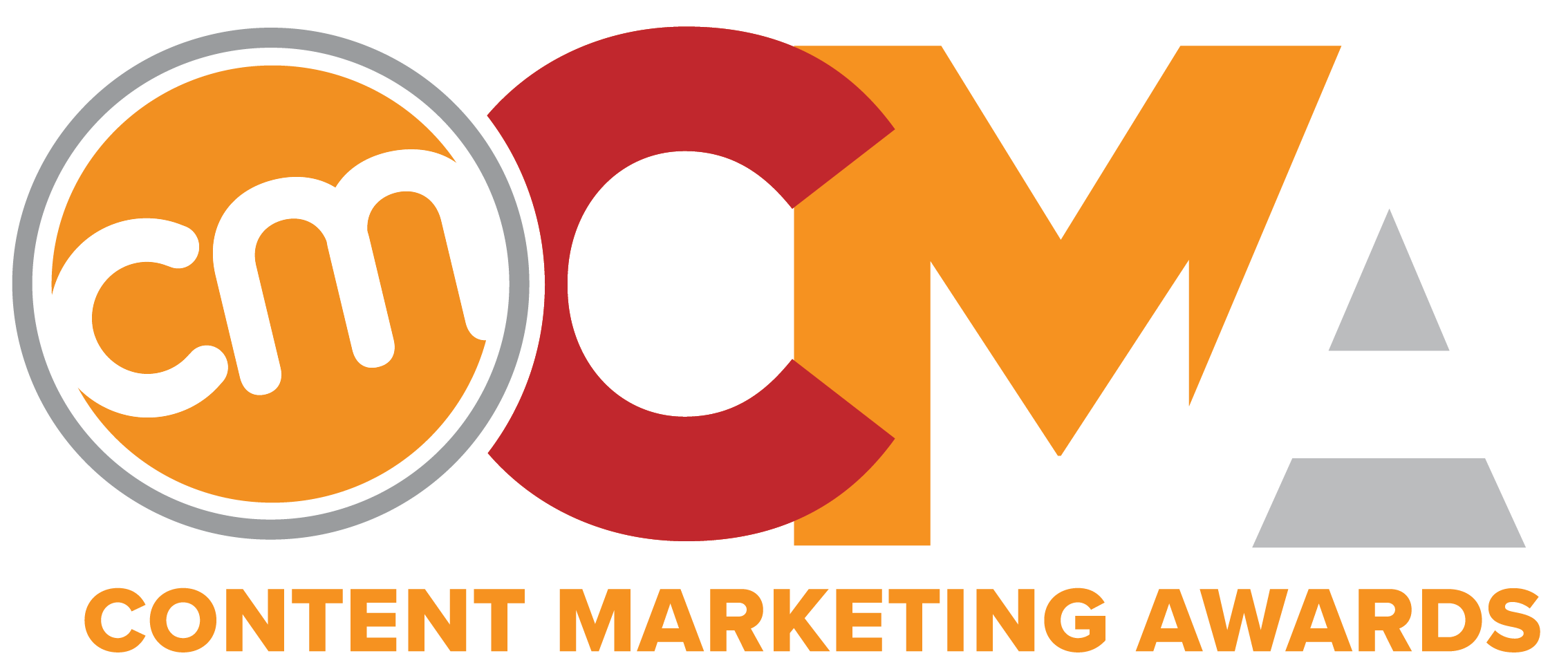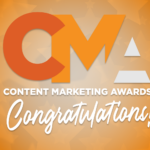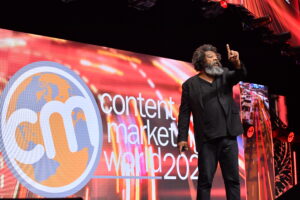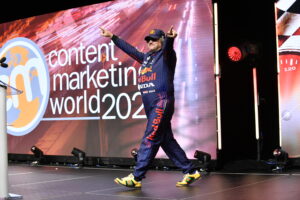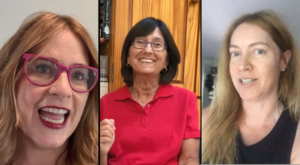
How is your brand or company using YouTube? Do you just post your video content, cross your fingers and hope for the best? Or do you actually want to generate sales for your business? There are effective ways to create valuable content and then ask for a sale, without killing your video’s growth potential on YouTube.
During this week’s Ask the #CMWorld Community livestream, CMI host Amanda Subler interviews CMWorld speaker Tim Schmoyer founder of Video Creators to chat about some of the best practices when it comes to using YouTube and some tactical tips on converting your viewers into sales.
Key Takeaways from the interview:
- There’s not a magic formula for YouTube success but if you focus on quality storytelling i.e., tell areally good story that’s been proven to hook someone’s attention, hold their attention, and then get them to take some sort of action at the end, you’re more likely to succeed.
- However, no one is going to watch your awesome content unless you can hook them with the thumbnail and title. Taking time to plan out your thumbnail and title is just as important planning out the actual video content.
- Companies make the mistake of asking YouTube viewers to do too much during their videos. Focus on one goal (or “ask”) for each video, whether that’s to keep the viewer watching videos or sending them off of YouTube to take an action on your website.
Watch this interview then come hear Tim Schmoyer speak at Content Marketing World 2022. Tim’s session is called “Creating A Sales Strategy for YouTube That Doesn’t Kill your Channel.” You can read the full description here. You can check out the entire agenda here.
You can participate in the interactive Ask the #CMWorld Community livestreams most Mondays at Noon ET on LinkedIn, YouTube, Facebook or Twitter. Check out some of the past interviews in this playlist.
Amanda Subler (06:18):
Some people think there’s a magic formula for YouTube, right? If you have the right length of video and you use the right keywords or you post it just the right time of day, you’ll have success on YouTube, but in your experience, what’s the most important element in finding success on YouTube.
Tim Schmoyer (06:51):
Yeah. There’s a lot of people trying that. And when they’re telling me like in a, in a consultation or something like, this is everything I’m doing, I’m using this tool for the keywords…. And all I have to do is just say, well, that sounds great. How’s that working for you? And then I was like, oh, well, <laugh>, I’m like, exactly. Okay. So, let’s try something different because we know the definition when you do the same thing over and over again and expect different results, right? So yeah, there’s not really a magic formula, but there are certainly some consistent principles that lead to growth more predictably than others. And our process starts with making sure that for you, first understand the target audience you’re going after. And I don’t mean like demographic info.
I mean like more, maybe even more psychographic, but just like, what is their story emotionally? What’s compelling them to look for content like this and to engage and watch. And then two, how do we quickly then get that first time viewer to feel like, where have you been my whole life? Like, this is exactly what I’m looking for. Right? And there’s a lot of signals that can help a first-time viewer pickup on and start feeling that way, fairly quickly. But to boil it all down, I mean, one it’s like, yeah, hook their attention, good titles, good thumbnails and good content, whatever good content is, but good content as defined by Google lately, after a lot of research, just to confirm what we probably already knew, which is that a good video that grows, you want the magic formula, so to speak, is if the closest formula to success would be something that would be more like, a hero’s journey, you know, a really good story that has been proven to hook someone’s attention, hold their attention, and then get them to take some sort of action as a result at the end.
Tim Schmoyer (08:42):
Last week was my wife. We celebrated our 16-year wedding anniversary, and we went to Rhode Island, had a good time together. And I made like a little video of our just, you know, some memories. And I brought with me the DSLR. I brought with me four different lenses. I brought with me the ND filters and the microphones and everything, but what did I end up using? I had all that in my bag, but I just used this (phone) the entire time I published that video and it performed exactly the same way as something would’ve if I put all the energy into just doing something fancier. And that was because the story was compelling about a guy and his wife, 16-year wedding anniversary, dancing alone together as the sun’s rising on the beach. You know, that is way more emotional and whether it’s caught on a phone or a DSLR, you know?
Amanda Subler (09:57):
So, we know good content, good storytelling, but there are a few tactical things because you talk a lot about titles and thumbnails and the importance of those, which I know we have been trying to work on all that on ourselves here on our team. So, what are sort of maybe some best practices when it comes to those type of things.
Tim Schmoyer (10:36):
Yeah. It doesn’t matter how amazing your story is. It doesn’t matter how emotional it is. And if you’ve got all the right signals and stuff in the project, if no one clicks on it in the first place, right? So, we really got to like quote, “sell” this video to get someone to even into it in the first place. And a lot of these same principles are true about how to get someone into your content, which is true, how you hold their attention. So, coming to titles and thumbnails specifically, it’s really important that the title and thumbnail creates intrigue. It has the spark curiosity. I work with a lot of creators- I think we’ve worked with, I don’t think, I know we worked a little over 4,000 creators and one of the most common things that we see for creators who are like “the content’s good.”
I’m like the content’s actually not bad, but this title and thumbnail is merely a description of the thing. It doesn’t actually tease the benefit or reward or value. There’s no like “that really happened!” or no, like there’s no question mark popping up above the viewer’s head that compels them to click on that thumbnail on that, on that title versus any of the other ones of this thing, which is, you know, content marketing 101. People have been making millions writing, good headlines for magazines and billboards and newspapers for a long time. And the same principles now just apply to YouTube. In terms of some, some, technical things for the thumbnail, two things we say that you have to remember it has to pass the glance test, which is like, if you’re crafting your YouTube thumbnail, just kind of look away and I want you to zoom.
Tim Schmoyer (12:14):
Usually, people edit their thumbnails in their full 4k or 10 DP resolution and we, like you to zoom out. So, it’s small, the way someone would see it as a suggested video on YouTube, you look away and then you kind of glance at it and look away again. And just like what stood out to me? Like where did my eye go when I only have when I only glance at it? Cause that’s closer to the environment that people will actually be experiencing that thumbnail on YouTube. And when you do that test, what you’ll likely find is a lot of the text you’re using is actually detracting from the visual that would spark some sort of curiosity. Too much text, will especially like not be helpful. Repeating the title of the video in the text of the thumbnail is redundant and unnecessary.
So, really focus on a really clear visual with the thumbnail. That’s what catches people’s eyes first. Then they typically look at the title. So those two things need to complement each other. We say, it’s got to be, you know, someone’s just on their phone and they’re just scrolling like this. It’s got to be a thumb-stopping thumbnail where someone’s like, “Whoa, what was that?! Let me back up a little bit!” So, thumb-stopping thumbnail, pass the glance, test spark curiosity, pitch, reward, value, benefit, all those are very important for getting people into your content in the first place.
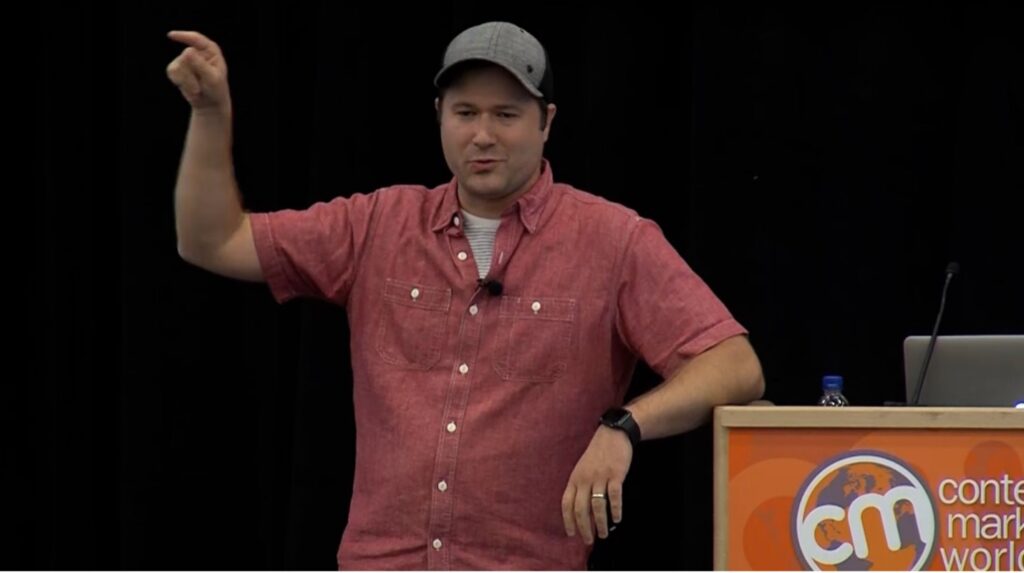
Amanda Subler (13:45):
You talk about, how you should think about those two things at the beginning of even, maybe before making the video, like those two things are just as important as making the video- the thumbnail and the title.
Tim Schmoyer (13:58):
Yeah. Title and the thumbnail. Yeah. We have some of our, our clients who have, you know, millions of subscribers. It’s not uncommon for them to spend a day just brainstorming all of the titles and thumbnails that they think their audience would click on. It doesn’t matter if they have a really good video idea. If they can’t come up with a good title and thumbnail, they know no one’s going to watch it. And so, they don’t bother to make the video unless they come up with a good title and thumbnail first.
Amanda Subler (14:24):
Mohamed is asking, what is the ideal text limit for thumbnail?

Tim Schmoyer (14:29):
Ideal zero? I don’t like text. I don’t want her to, it’s a lazy way of communicating when you’ve got a visual that you could use instead. So, I’m not saying that text can’t be used, but if you do use text, use it to compliment the title. So let me give you an example. We work with one brand, I can’t reveal who it is because I don’t have permission, but it is a big nationally known, think outdoor grills and cooking type of brand. Okay. So, they had a, they have a grill and they’re making this video and it’s like, the title is something like how to grill, chicken on this model grill. Right. They are getting all the right keywords in there. It’s a picture of the grill. And we’re like, no, no, no, no. That’s descriptive that doesn’t spark curiosity.
So, we changed the thumbnail too. Well, the thing that spark curiosity for me, do you know what spatchcock chicken is? Fanny name. No? I didn’t either. So, I’m watching this and what they do is they take out like the breastbone, and they flatten it out, the whole chicken out flat, and it looks like this mangled chicken. I’m like, what is that? And they’re like, oh, it cooks more evenly. Cause now the whole thing spread out and things. And I was like, well, there’s your thumbnail, right? That’s part, curiosity. So, forget about the grill. The only person who’s going to click on that title and thumbnail is someone who has that particular grill and doesn’t know how to grill chicken, right? They got a couple thousand views and stopped. So then, we had (the chicken) thumbnail, no text at all.
Tim Schmoyer (15:57):
It was just one side was like a whole chicken on the grill with a Red X and the other side was a spatchcock chicken looking mangled with the green check mark on it. And the title was just, you’re doing it wrong. No, there’s no keywords. No how to grill. No model number. Chicken wasn’t even in there. And YouTube doesn’t need any of that info. Because they’re scanning the video frame by frame while it’s uploading, matching it against copyrighted material, they can geotag where your video is shot based on like a mountain range in the background. Right? So, like they don’t need any of our keywords and titles or anything. They know what brand glasses you’re wearing, you know, everything. The roll, tilt and pan of your head, the emotional expressions, everything frame by frame. So, then we did change it that way, no text in the thumbnail or anything. And it shot, from like a couple thousand views to like 60,000 views in like a couple days after that, because it sparks curiosity. Right? And it, now it feels like I’m getting into like, how does that work? Right? So, and then they introduce their product to a whole bunch of people who never otherwise would’ve heard of them.
Amanda Subler (17:17):
Great. Let’s touch on this just quickly. When, you know, you’re looking at analytics, which, you know, can inform your strategy and tell you what kind of videos you want to create, what are some, things that people should be looking at when it comes to that and, how can analytics tell them how the video is working or performing?
Tim Schmoyer (17:39):
Yeah. There’s a, there’s a mountain of data in there. And I think most people don’t know what to, where to even start. Right?
And even when you get into it, it’s not clear what you’re supposed to do with all that information either, you know, so you get into it and then you’re like, okay, that’s good to know, but what do I do with that? So, we would recommend that you, look at the data that corresponds as clearly as it can to you, to what we call the viewing journey. So, you’re familiar with like a customer journey or, you know, a sales funnel, you know, type thing, like what brings them into the video, what hooks their attention, what holds their attention and what gets them to take the action, what we want them to take at the end. Right. So, if I’m going to like boil it all down to a nutshell, it’s really, click through rates on the titles and thumbnails. It is the audience retention graph for what is their reaction to while they’re watching this content?
Am I losing their attention regularly in like the first 10 seconds? And it goes from like a hundred percent to like 80 percent, like how did I lose 20% of my audience in the first 10 seconds? Well, that would be a really important question to figure out, to make better content. And then at the end, if I’m like trying to get someone to click and watch another video, for example, how do I, like, what do I need to do that gets, that increases the click through rate on the end screen, which would be another data point to look at. So those three there’s a lot more there, but like those three would be where I would start just because now you’re, you can use them to start, noticing trends and patterns into what’s effectively getting people in, holding their attention and getting them to click, to watch more, which is one of the strongest signals YouTube looks for when they’re deciding what content to surface is like how much time does spend someone spend on YouTube as a result of watching this video. So those would be the three.
Amanda Subler (19:34):
So, let’s dive in a little bit. You’ll be at content marketing world this year. And your session is about how to generate sales through your YouTube video. So, what is the number one mistake you see companies or brands doing when it comes to this
Tim Schmoyer (19:55):
Only one <laugh> oh, okay. I’m going to cheat a whole bunch into one. So, the, the main mistake is, and I don’t know why marketers don’t tend to make this mistake anywhere else in marketing world. I don’t know why they do it on YouTube. Because once I point it out, you’re probably going to do like a big face-palm and you’d be like, “Oh my gosh, of course!” Right? So, nowhere else in marketing world, do we have like 15 goals for one piece of content and they’re all equally important, right? We want every video we publish, it’s got to get a lot of views, got to get a lot of comments. It’s got to get a lot of subscribers. It needs to rank number one, it needs to hit the homepage. It needs to be a suggested video. It needs to go big on Reddit.
It’s got to generate a lot of traffic to our website, generate sales, email list, blah, blah, blah. And so, at the end of every video, it’s not, or even in the middle, it’s not uncommon for me to see people like, okay, go buy this. I got this free guide for you here, click this subscribe comment, like, you know, blah, blah, blah. And you guys know, like if you ask people to do more than two things, the likelihood of them doing either one of those things drops significantly. So, we work with our clients to say, just pick one thing. I know you can make a Swiss army knife video that does a lot of things and nothing. Well, right. We don’t want to do that. We want to make the video that is designed. This entire video is designed to accomplish this one thing specifically. So, at Content Marketing World, we’ll talk about how we take a content strategy and break them up into three different categories.
Tim Schmoyer (21:28):
And every video we do has to have one of these three goals and none of the others, because think about it. Like what I just shared is one of the strongest signals that YouTube looks for is how, if we surface this video, how much longer this person spends watching YouTube. And if the goal of your video is to end the viewing session, get people off of YouTube and onto your website. Well, now if YouTube’s got two different videos to surface, they got yours and people stay on YouTube, let say for another, two and a half minutes. And they got this other video where people stay on YouTube for another 30 minutes. I mean, YouTube’s surfacing this one all day long. Even if you’re click through rate is higher. Even if your watch time is higher, et cetera. So, it’s really important that we design content that only accomplishes one thing, whether it be like, “Hey, click and keep watching this video right here” and give a quick pitch for that. Whether that be to create community and spark engagement and comments, or that be to click the link, buy, download, sign up, register, whatever, and get people off of YouTube.
We just don’t want to mix those because we’re trying to make a video that’s intended to be discoverable and rank and perform well. But then the goals that end the viewing session, those are competing goals and they don’t work well. So, we’re going to talk at Content Marketing World. How do we split those two goals and make content that’s designed to do this and this and other stuff in between as well? So, yet you can now start mapping your entire sales funnel, customer journey kind of thing, right on your YouTube channel. So
Amanda Subler (23:09):
Andrew wants to know when you lose a large portion of your audience in the first 10 seconds, do you want to try the same content again? Tweak it? Do you delete the original? Do you leave it? What are some tips on that?

Tim Schmoyer (23:29):
It’s hard to know what the action step is in just one video. It’s usually a pattern you have to look for. So, for example, we work with one creator, one guy, whenever, he would say the word module, like people would just leave. Right? You wouldn’t know that by looking at just one video, but you got to look over lots of videos. You start seeing this pattern unfold. Very generally speaking though, Andrew, the most times when we see that type of behavior, is when there’s a high abandonment at the beginning of the video and you can’t find any pattern, typically the pattern is the title and thumbnail set an expectation that wasn’t immediately met or, the curiosity stretched out even further. So, for example, is the title of the video something like, “How to use spreadsheet for your taxes?” I don’t know something boring <and then it opens with, “Hey guys. Good to see you again. My name’s Andrew. And today we’re going to talk a little bit about how to use your spreadsheet for your taxes.” The audience is like, I know that’s why, get on with it. And, they’re just going, the tension that was in their brain that got them to click is dissipated immediately with that type of opening, as opposed to doing something like, they click on that title for example. And it’s like, “I’ve been using this other tool all the time and it’s cost me $10,000 in extra taxes a year. And then I can’t find it.” Like you start getting into the frustrations of why someone’s looking into this in the first place. You start getting a little into the little storytelling right there.
Tim Schmoyer (25:16):
And especially if there’s the emotion behind it, which, you know, there’s always emotion behind taxes, so that shouldn’t be too hard with this topic then, it’s now …that’s way more intriguing. And that increases the curiosity, right? So, you just got to the problem, most people have is they come to YouTube thinking about, approaching it like television, which is the media most people know, but this isn’t television. People come to it with very different behaviors, expectations. The viewing environment is called a lean-in experience where people aren’t distracted versus television, it’s called a lean back experience where people are usually multitasking. So, it’s very important that we increase tension or deliver immediately on the thing someone clicked for. So, without having seen your content, that’s the thing I would probably advise you to check out first.
Amanda Subler (26:05):
That is a great. I have a quick question right here. Kimberly wants to know; do you approach YouTube differently depending on B2B versus B2C?

Tim Schmoyer (26:18):
Not really. I still think it’s P2P which I call people to people, you know? It’s like, you’re not targeting a corporation. You’re still targeting a person at the corporation who has a problem they’re trying to solve. And, so yeah, great. It doesn’t change too much.
